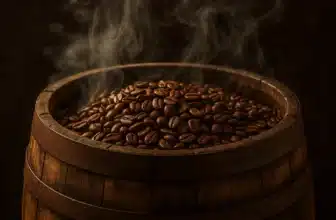
As you undoubtedly already know, making a decent cup of coffee may be done in a variety of ways today. Whatever the brewing method or equipment chosen, all of these techniques share one thing in common: they all use hot water to draw out the flavors and smells of ground coffee beans. In this post, we have outlined the most popular coffee brewing methods at home, easily and professionally.
We can argue that the way the coffee is made and its strength or weakness are determined by your personal preferences.
Simply because each approach appeals to a different connoisseur due to differences in culture, taste, flavor, and lifestyle, and offers a variety of benefits and drawbacks.
Quality, convenience, simplicity, or possibly just simple enthusiasm are additional significant factors in the coffee game. The main coffee brewing devices and vessels are described in the following material. It is extremely important to note and always keep in mind that, in addition to the brewing technique employed, every final coffee cup will also vary substantially depending on two crucial factors:
The type of roasted coffee beans comes first.
The quantity and quality of the coffee grind come in second.
1. The Filter Drip coffee brewing methods
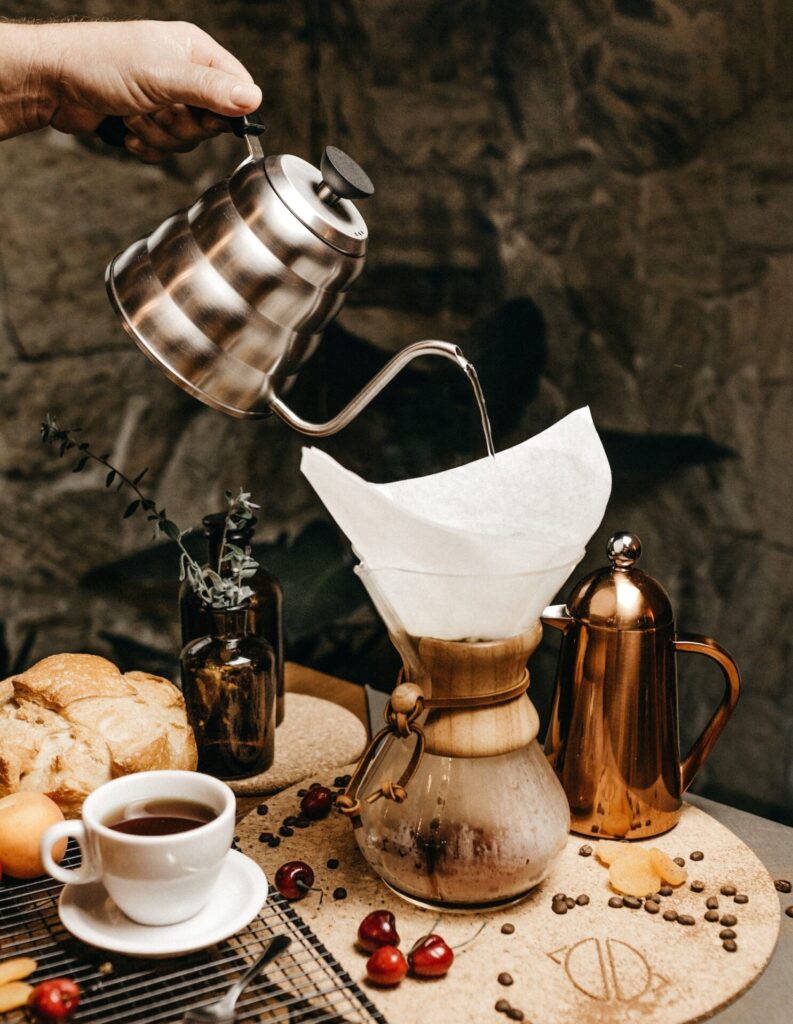
In North America and Europe, the filter drip methods are the ones that are most frequently used to make coffee. For a speedy and effective coffee extraction, they allow the use of very fine coffee grinds. In this method, a paper filter is first put in a holder made of plastic, glass, or ceramic. A glass carafe or coffee pot is placed on top of this filter holder. The filter is then filled with a portion of your finely ground coffee. Coffee grounds are covered with boiling water. The grounds stay in the filter for simple disposal while the freshly brewed coffee pours into the container below. Anyone can try this straightforward, traditional way.
2. The Automatic Drip Brewing Method

For metal filters, a fine to medium grind is preferable to medium for paper filters.
THE PROCESS When using an electric drip coffeemaker, you put the ground coffee in a paper filter that fits within the cone- or round-shaped filter of the device. Automatically heated hot water drops through the coffee bed and into a pot that is placed on the warmer plate of the machine.
Brewing guidelines for the automatic drip technique
Several key considerations while employing the drip method are as follows: Never leave the coffeepot on its electric burner for more than 15 to 20 minutes to avoid a burnt flavor. If you need to, you can always keep the coffee warm.
After the coffee has completed brewing, pour it straight into the carafe.
Just before pouring the first cup, stir the coffee in the pot to evenly distribute the scents.
BENEFITS of the drip technique
The majority of automatic coffee makers are wonderful whenever you want a quick, practical cup of coffee. You can trust this condition, especially before work and usually in the morning.
Simple cleanup because it is simple to discard the paper filters. Additionally, a reusable wire mesh filter can be used as an eco-friendly substitute for throwaway paper filters; these are sometimes provided separately by the coffeemaker’s manufacturer. Purchase just unbleached paper filters as a compromise.
DISADVANTAGES of the drip method
One of the most bothersome drawbacks is that white paper filters have undergone bleach processing and can absorb some of the flavor of the coffee.
As we previously mentioned, if a pot of coffee sits on the machine’s electric burner for too long, say for 30 minutes, the consequence may be a burnt, slightly bitter taste.
Additionally, overheating it might cause the coffee’s complete flavor to vanish.
3. The Manual Drip Brewing Method

For paper filters, medium is the best coffee grind; however, fine to medium is preferable for metal filters.
The automatic approach dispenses the ground coffee into the paper or wire mesh filter, which is fashioned to fit into a wedge-shaped filter holder, the flat base of which rests atop a carafe or other heat-resistant cup or mug. In a kettle, bring the water to a rolling boil. After giving the heated water a chance to cool for 20 seconds or so, slowly pour it over the ground coffee in the filter holder. The coffee will then begin to trickle into the container of your choice.
The best-known brands of this device are Chemex.
BREWING Instructions for manual drip method
Before filtering the coffee into the container, make sure to gently warm it by giving it a hot tap water rinse. After the water has boiled for about 20 seconds, begin pouring it over the ground coffee in the cone-shaped filter. Then, wait 45 seconds before adding the final bit of water. A concentration of subtle coffee scents and flavors is released when water first comes into contact with ground coffee.
Finally, you’ll see that the pre-moistened ground coffee packs into the deep bed in a smaller, denser volume, allowing the hot water to pass through them uniformly.

ADVANTAGES of the manual drip method
Here, you have complete control over the ccoffee-to-waterratio ratio and water temperature, which guarantees higher coffee quality than the automatic drip method offers. As opposed to the automatic method, which involves leaving the coffee carafe resting on a heated burner, the manual drip method does not burn or damage the coffee’s taste.
Generally speaking, this method is for those who enjoy making coffee outside, like while camping.
DISADVANTAGES of the manual drip method
Since it must be done manually, this approach will undoubtedly require more time and attention, but the coffee won’t be of a higher caliber because water must first be separately boiled before being manually poured through the coffee in the filter.
4. The Cold-Press Brewing Method

A cold coffee final concentration is produced by this method of cold brewing coffee.
Better Medium Ground Coffee Beans should be the best.
Here, this method uses a large, white plastic form that has a filter attached as the actual brewing container.
Medium-ground coffee should be added to the brewing vessel. Over the coffee in the filter, pour cold water. 5 minutes should pass without stirring. After that, gradually add more cups of cold water.
The. Now put the container into the fridge. Allow the coffee to steep for 12 hours.
Into a glass carafe, the liquid coffee will flow after passing through the filter. The finished concentrate should be kept in the sealed glass decanter that it trickled into after the cold-filtering procedure is finished. It should be tightly covered and kept in the refrigerator.
BREWING Instructions for the cold press method
You can mix 1 part concentrate with 3 parts cold water to make hot coffee, which you can then heat. Since it blends so nicely, this is the best way to make iced coffee. Over ice, combine 1 part concentrate with 2 parts water. Additionally, we discovered that cold coffee made in this manner freezes well.
ADVANTAGES of the cold press method
In comparison to coffee produced using conventional hot-water techniques, Toddy Coffee Makers claims that its cold brew technology yields far less acidity and extracted caffeine. It’s perfect for coffee shops, iced drink connoisseurs, and iced coffee recipes. The cold-press brew only needs ice to be finished. Also, this approach works well for coffee while camping.
DISADVANTAGES of the cold press method
Due to the generally lower extraction and brewing rates compared to the hot method, for fans of the French press and espresso, the flavors of the cold-press method are milder and less appealing.
This method creates more concentrate than you might want to store in the refrigerator and needs at least half a kilogram of coffee to begin brewing.
5. The French Press Brewing Method
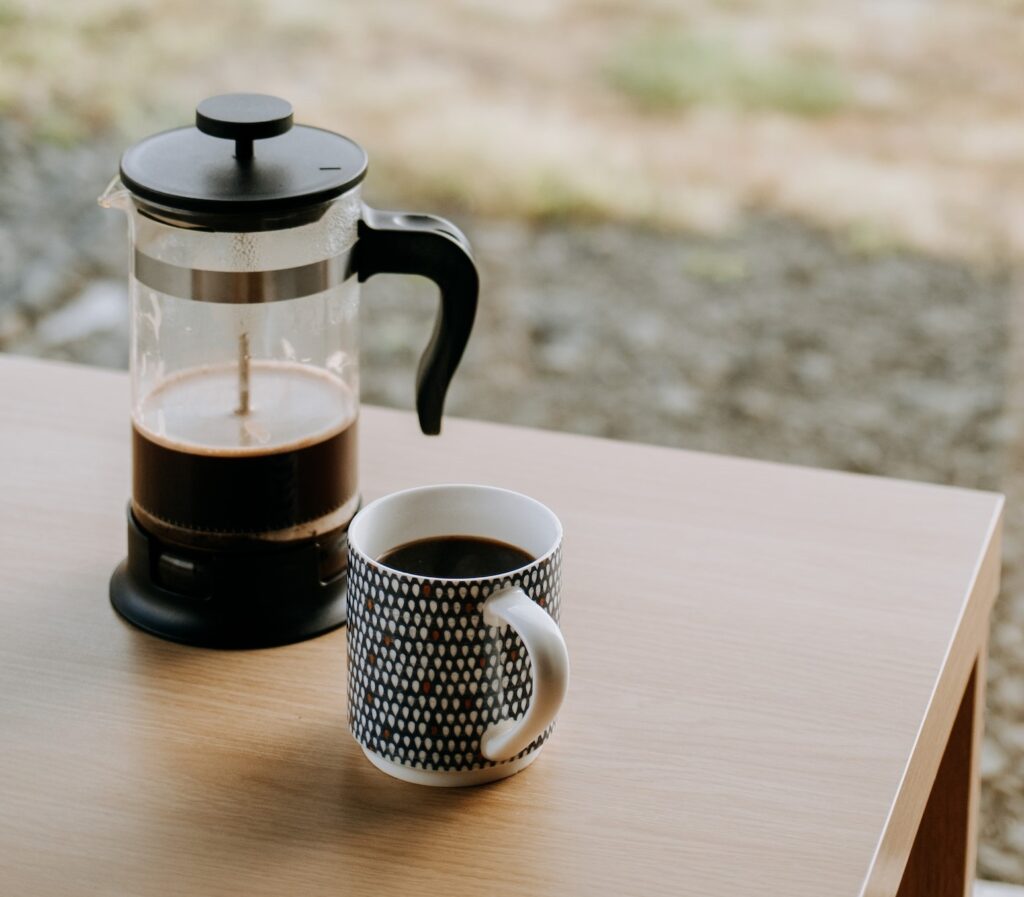
The French press, also referred to as the plunger-pot method, is simple to use and yields incredibly robust, frothy, and creamy coffee. After espresso, it is the best brew. Direct contact between the ground coffee and the boiling water that has been slightly cooled results in a fantastic flavor and aroma combination.
The COFFEE beans are preferred to be Medium to coarse ground
When using this METHOD, which I personally adore and frequently employ to make my daily cup of espresso coffee.
Take out the plunger, then rinse the glass French press with hot water to prepare it. Put your appropriate amount of coffee inside, then add some cooled, boiling water to fill it up. The beaker’s plunger lid should be replaced.
After allowing the coffee to steep for about five minutes, begin to slowly press the meshed plunger cover through the coffee suspension. After more pressing, the finished coffee will be instantly separated from the grounds, which are pushed or plunged all the way to the bottom of the pot.
BREWING Instructions for the French press method
200 cc of water and 30 ml of ground coffee are used. After thoroughly cleaning the glass plunger pot with hot water, add the ground coffee to the slightly cooled, boiling leftover water, and cover the pot with a terrycloth towel to steep it. The finished coffee will stay hotter longer as a result.
ADVANTAGES of the French press coffee brewing method
If this rapid approach is used professionally, it ensures that you will get the coffee with the richest body.
The steeping process takes less time than drip systems. Furthermore, less pressure is needed to apply. The ground coffee is steeped in water that has not yet reached the boiling point, retaining the dark, full scent and flavor without any traces of the bitterness that occasionally may be present.
For making cappuccinos and coffee lattes, the plunger pot of the French press is another excellent milk frother. It should only be heated in a microwave for less than a minute, and only until it is too hot to put your finger inside.
Transfer the milk right away to a clean, rinsed plunger pot, then begin to vigorously pump the plunger up and down in the pot for several seconds to up to four minutes until you get foamy frothed milk.
DISADVANTAGES of the French press method
Once the steeping process is complete, time may cause cooling. Additionally, if the coffee grind is too fine, using and depressing the plunger may be challenging. For this reason, coarse-ground beans are typically used.
Even more, given that this type of pot lacks a paper filter, additional cleanup is necessary.
6. The Vacuum Pot Method
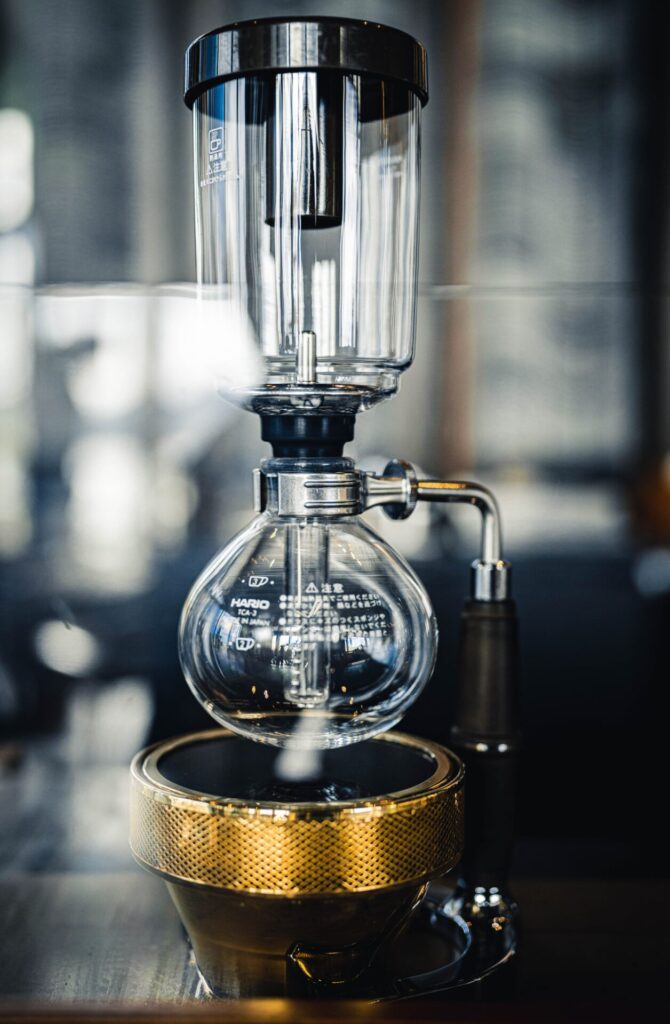
This technique was once the best for making a perfect, flavorful cup of coffee.
This technique involves hanging two glass globes with filters, one positioned inside the other, above a heat source. Its refined and alluring charm was in vogue more than 60 years ago.
The Best COFFEE GRIND is better to be Medium to fine
When using the vacuum METHOD, you place the ground coffee in the top glass globe and the cloth filter for the pot in the upper funnel. The lid is left open, and the coffee is then placed loosely around the filter. Place the lower globe’s stand on the ground and fill it with a kettle’s worth of boiling water.
Light the stand’s low flame, place the upper globe firmly on the base, and seal it securely with the bottom globe. At that point, the steam pressure will begin to push the boiling water into the tube within the upper globe, where the water will begin to infuse the ground coffee at this point.
Turn off the burner, stir the mixture, and let the coffee steep for no longer than two minutes. A vacuum will occur when the lower globe cools and shrinks, sucking the coffee into the lower globe. Remove the upper globe and pour the prepared beverage once all the coffee has flowed down.
BREWING Instructions of the vacuum brewing method
You should have to boil the water separately in a kettle, then pour it into the lower globe and light the vacuum pot’s heat source to start the steam-pressure process in order to assist this procedure to go more quickly.
ADVANTAGES of the vacuum brewing method
This approach is amazing and entertaining if you love the show that comes with creating a unique beverage. The pot is transportable and may be used anywhere, even without an outlet. This technique uses a traditional pot with cloth filters to produce superb, pure, and fine coffee.
DISADVANTAGES of the vacuum brewing method
This procedure is quite time-consuming, as we can see in this experiment that resembles one from a chemistry class. Since steam pressure is what drives the process, you must. The top globe cannot be removed until the coffee brewing procedure is fully finished. The vacuum pot is a tricky and complicated instrument as well.
7. The Middle Eastern ibrik or Turkish Method
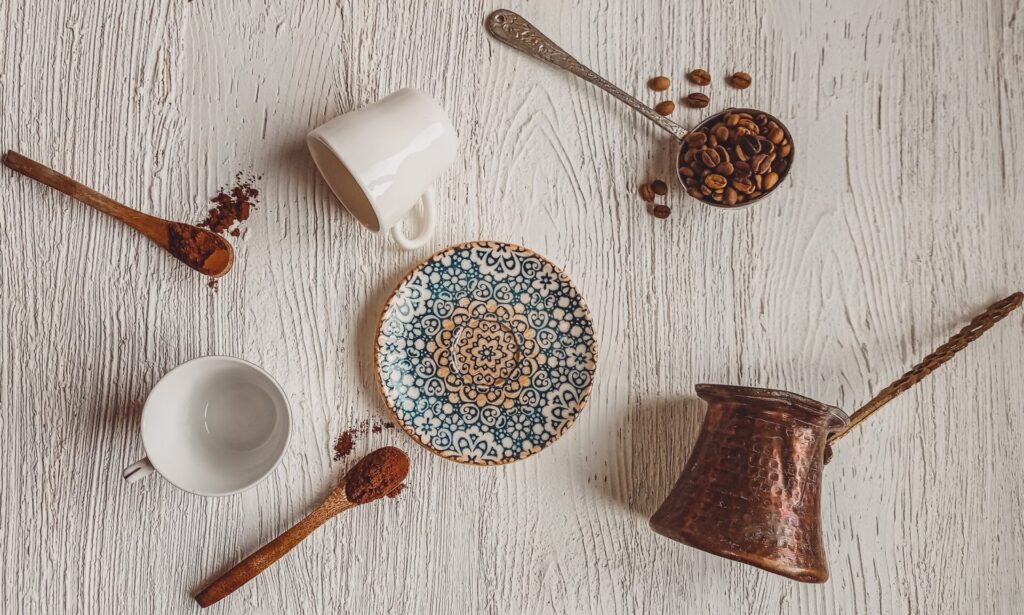
Each Middle Eastern nation has its own versions of this process, such as what is often called Turkish or Greek coffee. This process results in an extremely syrupy, heavy-bodied beverage. Similar methods are used to make Turkish coffee, which is made by boiling very finely ground coffee with water and sugar.
Best COFFEE GRIND is Pulverized to a powder as fine as cake flour
THE PROCESS It uses a coffee maker known as an ibrik (Turkish). This well-known long-handled copper or brass pot, known as “Wish” in Arabic, has a broad base and a narrow top that is designed to keep on.
Assuming two servings: Add 100 g of water, 2 heaping teaspoons, or 15 g of powder-fine coffee to a pot along with your preferred amount of sugar or not.
Up to a boil. When the coffee begins to foam, turn off the heat, wait for the foam to subside, then mix. To create a brew that is extremely thick, viscous, and muddy, repeat this heating step twice. After that, dispense the coffee into two cups or a sizable mug. Before sipping the coffee, let the grounds a moment to settle down a little.
BREWING Instructions for preparing Turkish coffee.

The ibrik should always be filled to half or slightly more of its maximum capacity. This is necessary because the coffee will foam up and expand, requiring the pot to have extra space.
If you prepare more than one cup, you might need to keep an eye on the coffee foams and, as soon as they are about to boil over, remove the pot from the heat and divide the remaining cups evenly with the foam.
To ensure that everyone receives an equal amount of coffee grounds and foam, it is customary to immediately pour the coffee.
Although some people might prefer the grounds to settle in the ibrik first, serving the grounds with the liquid coffee is necessary to preserve the tradition and unique flavor of this thick, sweet coffee.
While the coffee is heating up, add cardamom seeds, cinnamon, or nutmeg to the pot for some spiced and flavored variations.
The typical quantity of sugar may be equal to or less than the amount of ground coffee added in the Middle East, and as a personal variation.
ADVANTAGES of Turkish coffee making
If enough sugar has been added, this robust coffee is unexpectedly light and sweet once the grounds have settled. For those who taste it for the first time, the brewing process may be amazing, delicious, and enjoyable.
DISADVANTAGES of the Turkish coffee preparation method
It can be challenging for some people to make it perfectly the first time.
The process will not work if the coffee has not been ground to a fine enough consistency. Finding the right coffee and pot locally where you live may not be simple either.
Genuine Middle Eastern coffee preparation techniques include creating a substantial top head of brown froth on top of the coffee. However, it is not always possible for a beginner to attain, thus it might take some work.
8. The Percolator Method
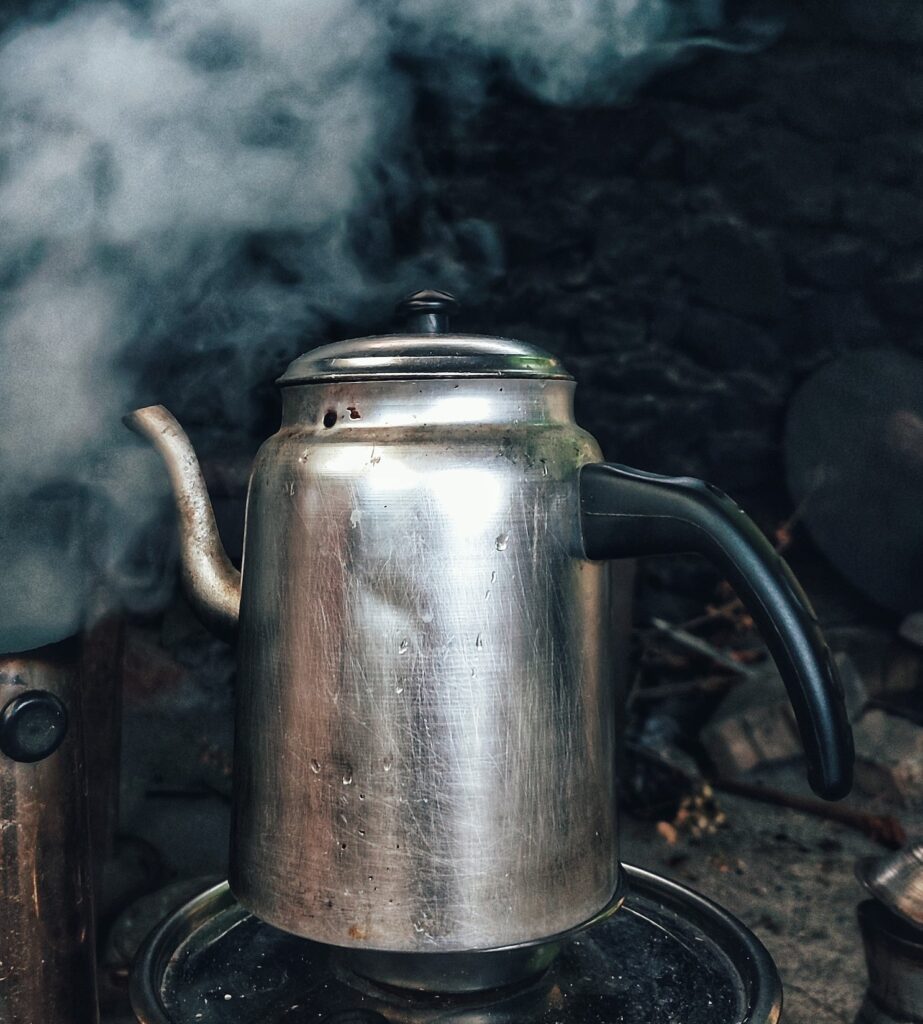
In the 1930s and 1940s of the previous century, percolator-brewed coffee had considerable popularity.
This technique essentially boils the coffee by forcing hot water up a tube into a basket of ground coffee. These pots eliminate the subtle coffee aromas and create an overly extracted, strong, and harsh beverage.
The best coffee grind for this recipe is medium to coarse.
Add cold water to the percolator. Put the filter basket containing the ground coffee inside the percolator. Cover it, then either set it on a burner on the stove or, if it’s electric, plug it in. Steam pressure from the hot water will propel it up through the coffee basket. After numerous repetitions, the water cycles repeatedly over the bed of coffee grounds as the pot emits its distinctive bubbling sound.
BREWING Instructions for the ercolator method
Use only coffee that has been coarsely ground.
ADVANTAGES of the percolator method
Strongly aromatic coffee is obtained by this method
DISADVANTAGES of the percolator method
Percolated coffee has constantly been warned about and linked to high cholesterol problems in medical research reports.



